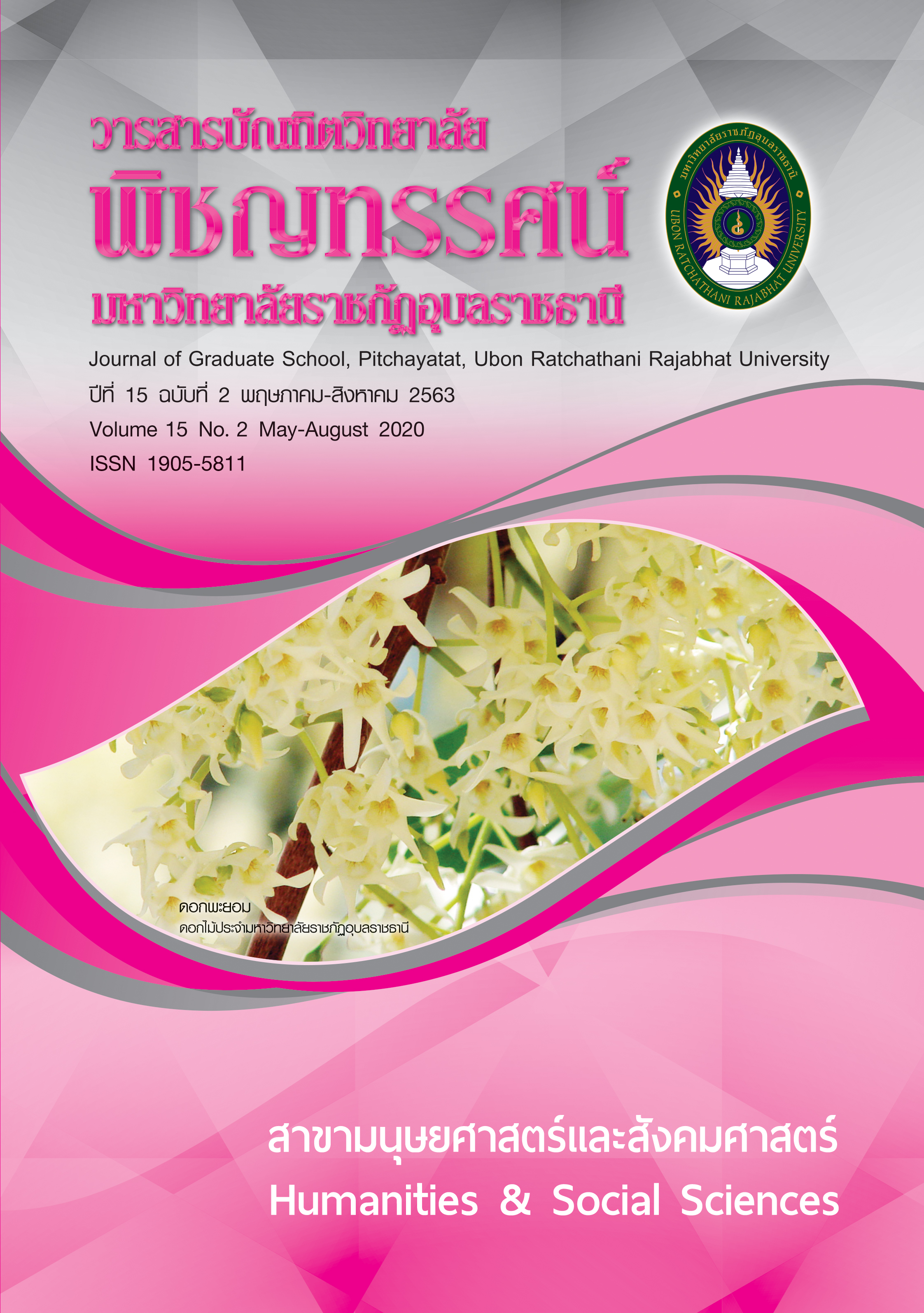รูปแบบพุทธบูรณาการการเสริมสร้างแรงจูงใจของผู้บริหารสถานศึกษา สังกัดสำนักงานเขตพื้นที่การศึกษามัธยมศึกษาเขต 42
คำสำคัญ:
รูปแบบ, พุทธบูรณาการ, แรงจูงใจ, ผู้บริหารสถานศึกษาบทคัดย่อ
บทคัดย่อ
การวิจัยมีวัตถุประสงค์เพื่อ 1) เพื่อศึกษาสภาพพุทธบูรณาการการเสริมสร้างแรงจูงใจของผู้บริหารสถานศึกษา สังกัดสำนักงานเขตพื้นที่การศึกษามัธยมศึกษา เขต 42 2) เพื่อสร้างรูปแบบพุทธบูรณาการการเสริมสร้างแรงจูงใจของผู้บริหารสถานศึกษา สังกัดสำนักงานเขตพื้นที่การศึกษามัธยมศึกษา เขต 42 และ 3) ประเมินรูปแบบพุทธบูรณาการการเสริมสร้างแรงจูงใจของผู้บริหารสถานศึกษา สังกัดสำนักงานเขตพื้นที่การศึกษามัธยมศึกษา เขต 42 ซึ่งเป็นการวิจัยเชิงพรรณนา กลุ่มเป้าหมายประกอบด้วย ขั้นตอนที่ 1 จำนวน 30 คน ใช้แบบสัมภาษณ์กึ่งโครงสร้าง และใช้การวิเคราะห์เนื้อหา ขั้นตอนที่ 2 จำนวน 12 รูป/คน โดยการจัดสนทนากลุ่ม เครื่องมือที่ใช้คือ แบบบันทึกการสนทนากลุ่ม และใช้การวิเคราะห์เนื้อหา ขั้นตอนที่ 3 ผู้ทรงคุณวุฒิ จำนวน 30 คน เครื่องมือที่ใช้เป็นแบบประเมิน สถิติที่ใช้ได้แก่ ร้อยละ และค่าเฉลี่ย
ผลการวิจัยพบว่า
- สภาพพุทธบูรณาการการเสริมสร้างแรงจูงใจของผู้บริหารสถานศึกษา สังกัดสำนักงานเขตพื้นที่การศึกษามัธยมศึกษา เขต 42 ประกอบด้วย 1) ด้านวันหยุด ผลตอบแทน สวัสดิการ บูรณาการ ตามหลักสังคหวัตถุ 4 2) ด้านสภาพแวดล้อมที่เอื้อต่อการทำงาน บูรณาการตามหลักสัปปายะ 4 3) ด้านลักษณะของหน่วยงาน บูรณาการตามหลักทุติยปาปณิกสูตร 4) ด้านผู้บังคับบัญชา และแนวทางการบริหารจัดการ บูรณาการตามหลักพรหมวิหาร 4 และ 5) ด้านลักษณะงานและความรับผิดชอบบูรณาการตามหลักอิทธิบาท 4
- รูปแบบพุทธบูรณาการการเสริมสร้างแรงจูงใจของผู้บริหารสถานศึกษา สังกัดสำนักงานเขตพื้นที่การศึกษามัธยมศึกษา เขต 42 ประกอบด้วย 5 รูปแบบ ดังนี้ รูปแบบที่ 1 ด้านวันหยุด ผลตอบแทน สวัสดิการตามหลักสังคหวัตถุ 4 รูปแบบที่ 2 ด้านสภาพแวดล้อมเอื้อต่อการทำงาน ตามหลักสัปปายะ 4 รูปแบบ ที่ 3 ด้านลักษณะของหน่วยงาน ตามหลักทุติยปาปณิกสูตร รูปแบบที่ 4 ด้านผู้บังคับบัญชา และแนวทางการบริหารจัดการตามหลักพรหมวิหาร 4 รูปแบบที่ 5 ด้านลักษณะงาน และความรับผิดชอบตามหลักอิทธิบาท 4
- รูปแบบพุทธบูรณาการการเสริมสร้างแรงจูงใจของผู้บริหารสถานศึกษา สังกัดสำนักงานเขตพื้นที่การศึกษามัธยมศึกษา เขต 42 มีความเหมาะสม เป็นประโยชน์ มีความถูกต้อง และมีความเป็นไปได้ในทางปฏิบัติ มากที่สุด
คำสำคัญ: รูปแบบ พุทธบูรณาการ แรงจูงใจ ผู้บริหารสถานศึกษา
เอกสารอ้างอิง
คณะกรรมการพัฒนาเศรษฐกิจและสังคมแห่งชาติ, สำนักงาน. แผนพัฒนาเศรษฐกิจและสังคมแห่งชาติ ฉบับที่ 12 พ.ศ. 2560-2564.กรุงเทพฯ: สำนักนายกรัฐมนตรี, 2560.
จิตราพัชร์ ชัยรัตนหิรัญกุล. “การศึกษาการจัดการความขัดแย้งในสถานศึกษาของผู้บริหารโรงเรียน สำนักงานเขตพื้นที่การศึกษามัธยมศึกษา เขต 42,” วารสารวิชาการเครือข่ายบัณฑิตศึกษามหาวิทยาลัยราชภัฏภาคเหนือ. 3, 5 (2556): 139-140.
พระธรรมโกศาจารย์ (ประยูร ธมฺมจิตฺโต). พุทธวิธีการบริหาร. กรุงเทพฯ: มหาจุฬาลงกรณราชวิทยาลัย, 2549.
พระธรรมปิฎก (ป.อ.ปยุตฺโต). พจนานุกรมพุทธศาสตร์ฉบับประมวลธรรม. กรุงเทพฯ: มหาจุฬาลงกรณราชวิทยาลัย, 2543.
พระพรหมคุณภาภรณ์ (ป.อ.ปยุตโต). สี่หน้าที่ของสตรีไทย. พิมพ์ครั้งที่ 3. กรุงเทพฯ: ผลิธัมม์, 2555.
พระราชสุทธิญาณมงคล (จรัญ ฐิตธมฺโม). กฎแห่งกรรมธรรมปฏิบัติ. กรุงเทพฯ: ธรรมสภา, 2549.
มัทนา วังถนอมศักดิ์. รูปแบบแรงจูงใจในการปฏิบัติงานของครู. กรุงเทพฯ: มหาวิทยาลัยศิลปากร, 2550.
วิชัย ธรรมเจริญ. ธรรมศึกษาตรี. กรุงเทพฯ: กลุ่มวิชาการพระพุทธศาสนาและจริยธรรมกองศาสนาศึกษา กรมการศาสตร์ กระทรวงศึกษาธิการ, 2543.
สมชาย ยอดเพชร และคณะ. “การนำเสนอแนวทางการเสริมสร้างแรงจูงใจการปฏิบัติงานของครูในสถานศึกษาขนาดเล็ก สังกัดสำนักงานคณะกรรมการการศึกษาขั้นพื้นฐาน,” วารสารศึกษาศาสตร์ มหาวิทยาลัยนเรศวร. 16, 1 (มกราคม – มีนาคม 2557): 90-92.
อาคม วัดไทสง. หน้าที่ผู้นำในการบริหารการศึกษา. สงขลา: มหาวิทยาลัยทักษิณ, 2547.
Clement, Evelyn. “A Study of the Relationship Between Intrinsic and Extrinsic Variables and Job Satisfactions Among Student-Personal Workers in Community Colleges,” Dissertation Abstracts International. 43, 8 (December 1983): 2567-A.
Sharon Conley and Ralph Levinson. “Teacher Work Redesign and Job Satisfaction,” Educational and Administration Quarterly, First Published Nov 1. 29, 4 (1993): 453-478.
ดาวน์โหลด
เผยแพร่แล้ว
รูปแบบการอ้างอิง
ฉบับ
ประเภทบทความ
สัญญาอนุญาต
บทความทุกเรื่องได้รับการตรวจความถูกต้องทางวิชาการโดยผู้ทรงคุณวุฒิภายนอกอย่างน้อย 2 คน ความคิดเห็นในวารสารบัณฑิตวิทยาลัย พิชญทรรศน์ มหาวิทยาลัยราชภัฏอุบลราชธานี เป็นความคิดเห็นของผู้เขียนมิใช่ความคิดเห็นของผู้จัดทำ จึงมิใช่ ความรับผิดชอบของบัณฑิตวิทยาลัย มหาวิทยาลัยราชภัฏอุบลราชธานี และบทความในวารสารบัณฑิตวิทยาลัย พิชญทรรศน์ มหาวิทยาลัยราชภัฏอุบลราชธานี สงวนสิทธิ์ตามกฎหมายไทย การจะนำไปเผยแพร่ต้องได้รับอนุญาตเป็นลายลักษณ์อักษรจากกองบรรณาธิการ






